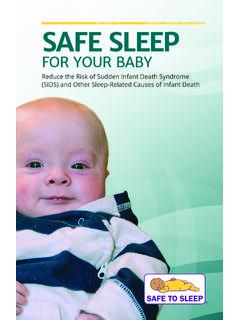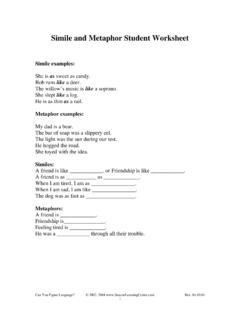Transcription of Milestone Moments Booklet 2021
1 1-800-CDC-INFO Learn the Signs. Act Early. Learn the Signs. Act Early. Milestone Moments Adapted from CARING FOR YOUR baby AND YOUNG CHILD: BIRTH TO AGE 5, Fifth Edition, edited by Steven Shelov and Tanya Remer Altmann 1991, 1993, 1998, 2004, 2009 by the American Academy of Pediatrics and BRIGHT FUTURES: GUIDELINES FOR HEALTH SUPERVISION OF INFANTS, CHILDREN, AND ADOLESCENTS, Third Edition, edited by Joseph Hagan, Jr., Judith S. Shaw, and Paula M. Duncan, 2008, Elk Grove Village, IL: American Academy of Pediatrics. Special acknowledgements to Susan P. Berger, PhD; Jenny Burt, PhD; Margaret Greco, MD; Katie Green, MPH, CHES; Georgina Peacock, MD, MPH; Lara Robinson, PhD, MPH; Camille Smith, MS, EdS; Julia Whitney, BS; and Rebecca Wolf, MA. You can follow your child s development by watching how he or she plays, learns, speaks, and acts.
2 Look inside for milestones to watch for in your child and how you can help your child learn and grow. Centers for Disease Centers for Disease Control and Prevention Control and Prevention 1-800-CDC-INFO 1-800-CDC-INFO 220788 How your child plays, learns, speaks, and acts offers important clues about your child s development. Developmental milestones are things most children can do by a certain age. Milestone Moments The lists that follow have milestones to look for when your child is: 2 Months .. page 3 6 4 Months .. page 7 10 6 Months .. page 11 14 9 Months .. page 15 18 1 page 19 22 18 Months (1 Years) .. page 23 26 2 page 27 30 3 page 31 34 4 page 35 38 5 page 39 42 Check the milestones your child has reached at each age. Take this with you and talk with your child s doctor at every visit about the milestones your child has reached and what to expect next.
3 For more information, go to 21 Learn the Signs. Act Early. | 1-800-CDC-INFO What babies do at this age Your baby at 2 Months Talk with your child s doctor at every visit about the milestones your child has reached and what to expect next. Social/Emotional How you can help your baby s development q Can briefly calm himself q Begins to smile at people (may bring hands to mouth and q Tries to look at parent suck on hand) Language/Communication q Coos, makes gurgling sounds q Turns head toward sounds Cognitive (learning, thinking, problem-solving) q Pays attention to faces q Begins to act bored (cries, fussy) q Begins to follow things with eyes if activity doesn t change and recognize people at a distance Cuddle, talk, and play with your baby during feeding, dressing, and bathing. Help your baby learn to calm herself. It s okay for her to suck on her fingers.
4 Begin to help your baby get into a routine, such as sleeping at night more than in the day, and have regular schedules. Getting in tune with your baby s likes and dislikes can help you feel more comfortable and confident. Act excited and smile when your baby makes sounds. Copy your baby s sounds sometimes, but also use clear language. Pay attention to your baby s different cries so that you learn to know what he wants. Talk, read, and sing to your baby . Play peek-a-boo. Help your baby play peek-a-boo, too. Place a baby -safe mirror in your baby s crib so she can look at herself. 43 Learn the Signs. Act Early. | 1-800-CDC-INFO Your baby at 2 Months Movement/Physical Development How you can help your baby s development q Can hold head up and begins q Makes smoother movements Look at pictures with your baby and talk about them. to push up when lying on with arms and legs Lay your baby on his tummy when he is awake and put toys near him.
5 Tummy Encourage your baby to lift his head by holding toys at eye level in front of him. Hold a toy or rattle above your baby s head and encourage her to reach for it. Hold your baby upright with his feet on the floor. Sing or talk to your baby as he is upright. q Doesn t respond to loud sounds q Doesn t watch things as they move q Doesn t smile at people q Doesn t bring hands to mouth q Can t hold head up when pushing up when on tummy Act early by talking to your child s doctor if your child: Tell your child s doctor or nurse if you notice any of these signs of possible developmental delay for this age, and talk with someone in your community who is familiar with services for young children in your area, such as your state s public early intervention program. For more information, go to 65 Learn the Signs. Act Early. | 1-800-CDC-INFO Your baby at 4 Months Talk with your child s doctor at every visit about the milestones your child has reached and what to expect next.
6 What babies do at this age Social/Emotional How you can help your baby s development q Smiles spontaneously, especially at people q Likes to play with people and might cry when playing stops q Copies some movements and facial expressions, like smiling or frowning Language/Communication q Begins to babble q Cries in different ways to show q Babbles with expression and hunger, pain, or being tired copies sounds he hears Hold and talk to your baby ; smile and be cheerful while you do. Set steady routines for sleeping and feeding. Pay close attention to what your baby likes and doesn t like; you will know how best to meet his needs and what you can do to make your baby happy. Copy your baby s sounds. Act excited and smile when your baby makes sounds. Have quiet play times when you read or sing to your baby . Give age-appropriate toys to play with, such as rattles or colorful pictures.
7 Play games such as peek-a-boo. Provide safe opportunities for your baby to reach for toys and explore his surroundings. Put toys near your baby so that she can reach for them or kick her feet. 87 Learn the Signs. Act Early. | 1-800-CDC-INFO Your baby at 4 Months Cognitive (learning, thinking, problem-solving) How you can help your baby s development q Lets you know if she is happy or sad q Responds to affection q Reaches for toy with one hand q Uses hands and eyes together, such as seeing a toy and reaching for it q Holds head steady, unsupported q Can hold a toy and shake it and q Pushes down on legs when feet swing at dangling toys are on a hard surface q Brings hands to mouth q May be able to roll over from q When lying on stomach, pushes tummy to back up to elbows q Follows moving things with eyes Put toys or rattles in your baby s hand and help him to hold them.
8 From side to side Hold your baby upright with feet on the floor, and sing or talk to your q Watches faces closely baby as she stands with support. q Recognizes familiar people and things at a distance Movement/Physical Development q Doesn t watch things as they move q Doesn t smile at people q Can t hold head steady q Doesn t coo or make sounds q Doesn t bring things to mouth q Doesn t push down with legs when feet are placed on a hard surface q Has trouble moving one or both eyes in all directions Tell your child s doctor or nurse if you notice any of these signs of possible developmental delay for this age, and talk with someone in your community who is familiar with services for young children in your area, such as your state s public early intervention program. For more information, go to Act early by talking to your child s doctor if your child: 109 Learn the Signs.
9 Act Early. | 1-800-CDC-INFO Your baby at 6 Months Talk with your child s doctor at every visit about the milestones your child has reached and what to expect next. What babies do at this age Social/Emotional How you can help your baby s development q Knows familiar faces and begins to know if someone is a stranger q Likes to play with others, especially parents q Responds to sounds by making sounds q Strings vowels together when babbling ( ah, eh, oh ) and likes taking turns with parent while making sounds q Responds to other people s emotions and often seems happy q Likes to look at self in a mirror q Responds to own name q Makes sounds to show joy and displeasure q Begins to say consonant sounds (jabbering with m, b ) Play on the floor with your baby every day. Learn to read your baby s moods. If he s happy, keep doing what you are doing.
10 If he s upset, take a break and comfort your baby . Show your baby how to comfort herself when she s upset. She may suck on her fingers to self soothe. Use reciprocal play when he smiles, you smile; when he makes sounds, you copy them. Repeat your child s sounds and say simple words with those sounds. For example, if your child says bah, say bottle or book. Read books to your child every day. Praise her when she babbles and reads too. When your baby looks at something, point to it and talk about it. When he drops a toy on the floor, pick it up and give it back. This game helps him learn cause and effect. Read colorful picture books to your baby . Language/Communication 1211 Learn the Signs. Act Early. | 1-800-CDC-INFO Your baby at 6 Months Cognitive (learning, thinking, problem-solving) How you can help your baby s development q Looks around at things nearby q Shows curiosity about things and tries to get things that are out of reach q Rolls over in both directions q Begins to sit without support (front to back, back to front) q Rocks back and forth, sometimes q When standing, supports weight crawling backward before on legs and might bounce moving forward q Brings things to mouth q Begins to pass things from one hand to the other Point out new things to your baby and name them.


















